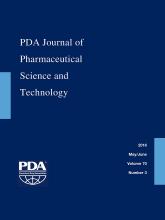Abstract
Certain types of glass vials used as primary containers for liquid formulations of biopharmaceutical drug products have been observed with delamination that produced small glass like flakes termed lamellae under certain conditions during storage. The cause of this delamination is in part related to the glass surface defects, which renders the vials susceptible to flaking, and lamellae are formed during the high-temperature melting and annealing used for vial fabrication and shaping. The current European Pharmacopoeia method to assess glass vial quality utilizes acid titration of vial extract pools to determine hydrolytic resistance or alkalinity. Four alternative techniques with improved throughput, convenience, and/or comprehension were examined by subjecting seven lots of vials to analysis by all techniques. The first three new techniques of conductivity, flame photometry, and inductively coupled plasma mass spectrometry measured the same sample pools as acid titration. All three showed good correlation with alkalinity: conductivity (R2 = 0.9951), flame photometry sodium (R2 = 0.9895), and several elements by inductively coupled plasma mass spectrometry [(sodium (R2 = 0.9869), boron (R2 = 0.9796), silicon (R2 = 0.9426), total (R2 = 0.9639)]. The fourth technique processed the vials under conditions that promote delamination, termed accelerated lamellae formation, and then inspected those vials visually for lamellae. The visual inspection results without the lot with different processing condition correlated well with alkalinity (R2 = 0.9474). Due to vial processing differences affecting alkalinity measurements and delamination propensity differently, the ratio of silicon and sodium measurements from inductively coupled plasma mass spectrometry was the most informative technique to assess overall vial quality and vial propensity for lamellae formation. The other techniques of conductivity, flame photometry, and accelerated lamellae formation condition may still be suitable for routine screening of vial lots produced under consistent processes.
LAY ABSTRACT: Recently, delamination that produced small glass like flakes termed lamellae has been observed in glass vials that are commonly used as primary containers for pharmaceutical drug products under certain conditions during storage. The main cause of these lamellae was the quality of the glass itself related to the manufacturing process. Current European Pharmacopoeia method to assess glass vial quality utilizes acid titration of vial extract pools to determine hydrolytic resistance or alkalinity. As alternative to the European Pharmacopoeia method, four other techniques were assessed. Three new techniques of conductivity, flame photometry, and inductively coupled plasma mass spectrometry measured the vial extract pool as acid titration to quantify quality, and they demonstrated good correlation with original alkalinity. The fourth technique processed the vials under conditions that promote delamination, termed accelerated lamellae formation, and the vials were then inspected visually for lamellae. The accelerated lamellae formation technique also showed good correlation with alkalinity. Of the new four techniques, inductively coupled plasma mass spectrometry was the most informative technique to assess overall vial quality even with differences in processing between vial lots. Other three techniques were still suitable for routine screening of vial lots produced under consistent processes.
- Glass
- Vials
- Lamellae
- Delamination
- Alkalinity
- Conductivity
- ICP-MS
- Flame photometry
- Accelerated lamellae formation
- © PDA, Inc. 2016
PDA members receive access to all articles published in the current year and previous volume year. Institutional subscribers received access to all content. Log in below to receive access to this article if you are either of these.
If you are neither or you are a PDA member trying to access an article outside of your membership license, then you must purchase access to this article (below). If you do not have a username or password for JPST, you will be required to create an account prior to purchasing.
Full issue PDFs are for PDA members only.
Note to pda.org users
The PDA and PDA bookstore websites (www.pda.org and www.pda.org/bookstore) are separate websites from the PDA JPST website. When you first join PDA, your initial UserID and Password are sent to HighWirePress to create your PDA JPST account. Subsequent UserrID and Password changes required at the PDA websites will not pass on to PDA JPST and vice versa. If you forget your PDA JPST UserID and/or Password, you can request help to retrieve UserID and reset Password below.






